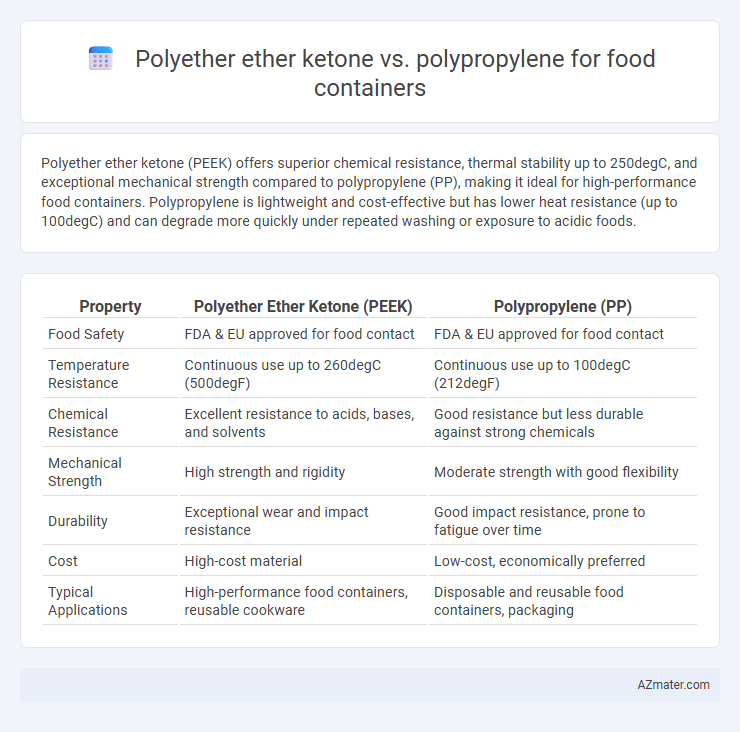Polyether ether ketone (PEEK) offers superior chemical resistance, thermal stability up to 250degC, and exceptional mechanical strength compared to polypropylene (PP), making it ideal for high-performance food containers. Polypropylene is lightweight and cost-effective but has lower heat resistance (up to 100degC) and can degrade more quickly under repeated washing or exposure to acidic foods.
Table of Comparison
| Property | Polyether Ether Ketone (PEEK) | Polypropylene (PP) |
|---|---|---|
| Food Safety | FDA & EU approved for food contact | FDA & EU approved for food contact |
| Temperature Resistance | Continuous use up to 260degC (500degF) | Continuous use up to 100degC (212degF) |
| Chemical Resistance | Excellent resistance to acids, bases, and solvents | Good resistance but less durable against strong chemicals |
| Mechanical Strength | High strength and rigidity | Moderate strength with good flexibility |
| Durability | Exceptional wear and impact resistance | Good impact resistance, prone to fatigue over time |
| Cost | High-cost material | Low-cost, economically preferred |
| Typical Applications | High-performance food containers, reusable cookware | Disposable and reusable food containers, packaging |
Introduction to Food-Grade Plastics
Polyether ether ketone (PEEK) and polypropylene (PP) are prominent food-grade plastics known for their safety and compliance with FDA regulations. PEEK offers exceptional chemical resistance, high thermal stability up to 250degC, and durability, making it ideal for repeated sterilization in food containers. Polypropylene is widely favored for its cost-effectiveness, moderate chemical resistance, and temperature tolerance up to 120degC, commonly used in disposable and reusable food packaging.
What is Polyether Ether Ketone (PEEK)?
Polyether Ether Ketone (PEEK) is a high-performance thermoplastic known for its exceptional mechanical strength, chemical resistance, and thermal stability, making it ideal for demanding food container applications. Unlike Polypropylene, which is widely used due to its cost-effectiveness and flexibility, PEEK offers superior durability and can withstand higher temperatures without deformation or leaching harmful substances. These properties make PEEK suitable for sterilizable and long-lasting food containers in industrial and medical food processing environments.
What is Polypropylene (PP)?
Polypropylene (PP) is a thermoplastic polymer widely used for food containers due to its excellent chemical resistance, high melting point around 160degC, and durability. It is lightweight, cost-effective, and safe for food contact, making it a preferred material for packaging and storage. In comparison, Polyether ether ketone (PEEK) offers superior mechanical strength and thermal stability but at a significantly higher cost, which limits its use in common food container applications.
Chemical Resistance: PEEK vs Polypropylene
Polyether ether ketone (PEEK) exhibits superior chemical resistance compared to polypropylene (PP), maintaining stability against strong acids, bases, and organic solvents commonly encountered in food processing environments. PEEK's high melting point and resistance to hydrolysis ensure long-term durability in aggressive cleaning cycles, whereas polypropylene may degrade or warp when exposed to certain chemicals and elevated temperatures. Selecting PEEK for food containers guarantees enhanced chemical inertness, reducing contamination risks and extending product lifespan in demanding applications.
Temperature Tolerance and Heat Stability
Polyether ether ketone (PEEK) offers superior temperature tolerance withstanding continuous use up to 250degC, making it ideal for high-heat food processing applications. Polypropylene (PP) has lower heat stability, performing well up to 100degC but prone to deformation and chemical degradation beyond this threshold. The high thermal resistance of PEEK ensures long-term durability and safety in sterilization, whereas PP is better suited for moderate-temperature storage and microwave reheating.
Mechanical Strength and Durability Comparison
Polyether ether ketone (PEEK) exhibits superior mechanical strength and durability compared to polypropylene (PP) in food container applications, with tensile strength typically around 90-100 MPa versus PP's 30-40 MPa. PEEK offers exceptional resistance to wear, high temperatures up to 250degC, and chemical degradation, ensuring long-term durability under harsh conditions. In contrast, polypropylene, while cost-effective and chemically resistant, maintains lower mechanical performance and degrades faster under thermal stress, limiting its lifespan in demanding food storage environments.
Food Safety and Regulatory Approvals
Polyether ether ketone (PEEK) offers superior chemical resistance, thermal stability up to 260degC, and excellent mechanical properties, making it highly suitable for food containers that require sterilization and durability. Polypropylene (PP) is widely used due to its FDA and EFSA approvals for food contact, recognized safety profile, and cost-effectiveness, though it has a lower melting point around 160degC, limiting its use in high-temperature applications. Both materials comply with major food safety regulations, but PEEK's advanced performance supports specialized food containers requiring rigorous sterilization and long-term chemical exposure.
Cost Efficiency: PEEK vs Polypropylene
Polypropylene offers superior cost efficiency for food containers due to its low raw material price and ease of processing, making it ideal for mass production and disposable use. In contrast, Polyether ether ketone (PEEK) has a significantly higher cost driven by its advanced thermal stability and chemical resistance properties, which are typically reserved for specialized, high-performance applications. While PEEK's durability can reduce replacement frequency in demanding environments, polypropylene remains the preferred choice for economical and large-scale food packaging solutions.
Common Applications in Food Containers
Polyether ether ketone (PEEK) and polypropylene (PP) are widely used materials in food container manufacturing due to their durability and safety. PEEK is preferred for high-performance applications requiring chemical resistance and high-temperature tolerance, such as reusable containers for sterile or processed foods. Polypropylene is commonly used for everyday food storage containers because of its lightweight, flexibility, and resistance to moisture, making it ideal for microwave-safe and disposable packaging.
Conclusion: Which Material is Best for Food Storage?
Polyether ether ketone (PEEK) offers superior chemical resistance, high thermal stability up to 250degC, and excellent mechanical strength, making it ideal for long-term, high-performance food storage applications. Polypropylene (PP) is more cost-effective with good chemical resistance and temperature tolerance up to 100degC, suitable for everyday use and microwave-safe containers. For premium, durable, and heat-resistant food containers, PEEK is the best choice, while PP is more practical for economical, low-heat food storage solutions.

Infographic: Polyether ether ketone vs Polypropylene for Food container
 azmater.com
azmater.com